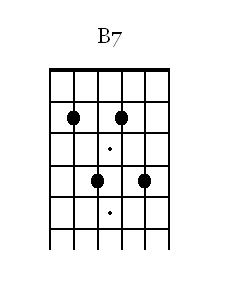Disclosure: I am an affiliate of Clickbank.com
You receive a FREE E-BOOK !!! "Learn to Play Guitar."
When you sign up for our mailing list.
Enter your email above to join and get the latest info in the guitar universe.
Dominant 7th Chords
The dominant 7th chord is a major triad with an added flat seventh scale degree. For example, the notes for a C seventh shape are CEG Bb. Notice that the note B is flat where as normally in the key of C major you would have a B natural note. This means that you are really playing in the tonality of the key of F maj. or C mixolydian

Here is one of the more common shapes I use on guitar. This one is based on the key of B. Using all four fingers in the left hand, you can see this is similar to power chord but with the seventh on the 3rd string instead of the repeated octave.
You have the root on the A string played with the 1st finger. The 5th is on the D string with the ring finger, and subsequently the 7th and 3rd scale degrees are on the G and B strings. This is a great practical and useful shape.
The seventh shape tends to resolve to a major or minor tonic a fifth below or a tritone up. In the key of A minor, for example, you naturally have a minor occurring. By sharpening the G note in E minor, to a G # and adding the G notes, you can create this kind of sound in the minor key as well resulting in harmonic minor scale.
To Shop for Guitar from Dominant 7th Chords
Adding the flat seventh scale degree creates a stronger gravitational pull than just using a straight major triad. Try playing a G maj to C maj, and then G seven to C maj, notice that the seventh (the note F) resolves to the 3rd of the C maj chord (the note E)
The tension in the seventh configuration is created by the tritone between the third and seventh which resolve to the root and 3rd of the tonic in contrary motion. For example, the B and F notes in a G7 resolve to the C and E of C major.


